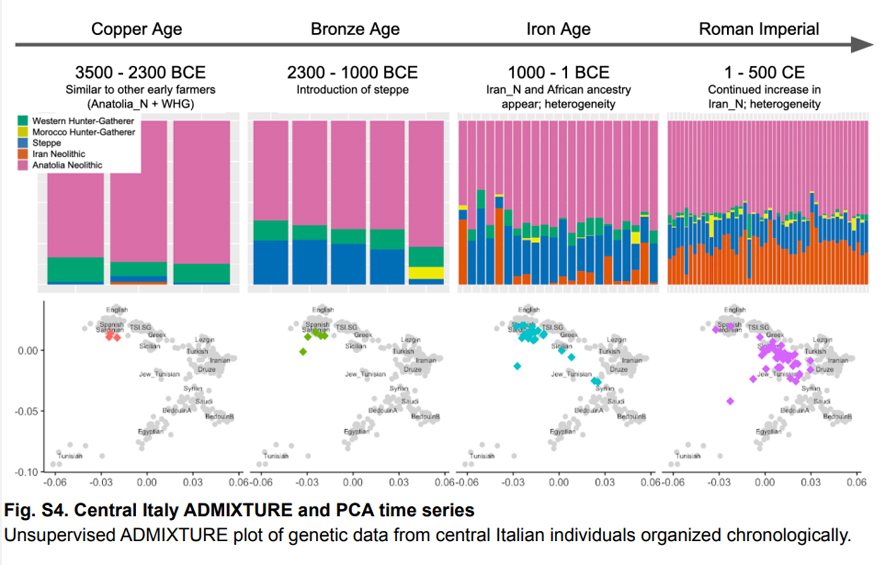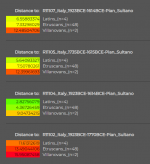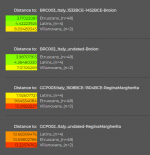Install the app
How to install the app on iOS
Follow along with the video below to see how to install our site as a web app on your home screen.

Note: This feature currently requires accessing the site using the built-in Safari browser.
You are using an out of date browser. It may not display this or other websites correctly.
You should upgrade or use an alternative browser.
You should upgrade or use an alternative browser.
How much genetic impact did the Italic migration have on the local population?
- Thread starter Poxy
- Start date
Francesco
Regular Member
- Messages
- 303
- Reaction score
- 267
- Points
- 63
- Ethnic group
- Italian (tuscan)
As far as I know, we are not even sure when italics entered Italy. Probably they did not even arrive In a single wave, but across multiple expansions, as some linguistics have suggested. Was the Protovillanovan culture linked to their first coming to Italy, or did they had already settled the peninsula during the middle bronze age, with the Terramare culture, or perhaps even earlier? We don't know. So, it's hard to define, genetically, what a pre-italic population would have looked like.
Maybe those samples you posted from Broion and Regina Margherita caves are already linked to an italic expansion, who knows.
Maybe those samples you posted from Broion and Regina Margherita caves are already linked to an italic expansion, who knows.
As far as I know, we are not even sure when italics entered Italy. Probably they did not even arrive In a single wave, but across multiple expansions, as some linguistics have suggested. Was the Protovillanovan culture linked to their first coming to Italy, or did they had already settled the peninsula during the middle bronze age, with the Terramare culture, or perhaps even earlier? We don't know. So, it's hard to define, genetically, what a pre-italic population would have looked like.
Maybe those samples you posted from Broion and Regina Margherita caves are already linked to an italic expansion, who knows.
Thank you for answer. While watching a video about the Terramare culture, I suddenly had questions about their genetic profile, so I looked for something related, and more questions arose.
I thought italics had penetrated around the same time as the collapse of the Terramare culture.
Francesco
Regular Member
- Messages
- 303
- Reaction score
- 267
- Points
- 63
- Ethnic group
- Italian (tuscan)
Some do indeed believe that the collapse of the Terramare culture is to be linked with an invasion by italic tribes, wich brought to Italy the Protovillanovan culture of the late-final bronze age. Others think that the Terramare culture itself is to be attributed to some kind of earlier italic migration to the peninsula, later displaced by a second wave of proto-italics.Thank you for answer. While watching a video about the Terramare culture, I suddenly had questions about their genetic profile, so I looked for something related, and more questions arose.
I thought italics had penetrated around the same time as the collapse of the Terramare culture.
Another theory says that the Terramare collapse was due to some kind of economic or ambientale crisis and that there was no migration or invasion between the Terramare a d protovillanovian period. Anyway, I'm not an expert on the matter.
Francesco
Regular Member
- Messages
- 303
- Reaction score
- 267
- Points
- 63
- Ethnic group
- Italian (tuscan)
Italic tribes were those who had Iran_N ancestry.

The Iran Neolithic admixture is a signal from the Aegean, brought to Italy by myceneans and Iron age Greeks and probably even before by a Minoan like population. We don't have any element suggesting that proto italic tribes were Iran Neolithic admixed before entering the peninsula.
The Iran Neolithic admixture is a signal from the Aegean, brought to Italy by myceneans and Iron age Greeks and probably even before by a Minoan like population. We don't have any element suggesting that proto italic tribes were Iran Neolithic admixed before entering the peninsula.
There were just some Greek colonies in the south of Italy, this large amount of Iran_N ancestry in Central Italy couldn't be related to Greeks.
Francesco
Regular Member
- Messages
- 303
- Reaction score
- 267
- Points
- 63
- Ethnic group
- Italian (tuscan)
The samples from the imperial era you are seeing are largely from Anatolia (see Lazaridis, 2022), that explains the high Iran_N. Nothing to do with proto-italics, I'm afraid.
Their presence in central Italy in the imperial era probably brought additional Iran_N, already introduced in the peninsula by the Greeks (and Minoans and Myceneans before them), whose presence was quite important.
To what extent Iran_N in contemporary Italy is due to the Iron Age Greeks colonization or to a later hellenistic anatolian influx is a matter for debate, but claiming it's due to the proto-italics it's quite heterodox to say the least.
I can see you are trying to advocate for an Iranian origin for the indoeuropean languages, a theory against whom I have nothing, but wich is not supported by current paleogenetic studies.
Their presence in central Italy in the imperial era probably brought additional Iran_N, already introduced in the peninsula by the Greeks (and Minoans and Myceneans before them), whose presence was quite important.
To what extent Iran_N in contemporary Italy is due to the Iron Age Greeks colonization or to a later hellenistic anatolian influx is a matter for debate, but claiming it's due to the proto-italics it's quite heterodox to say the least.
I can see you are trying to advocate for an Iranian origin for the indoeuropean languages, a theory against whom I have nothing, but wich is not supported by current paleogenetic studies.
Palermo Trapani
Regular Member
- Messages
- 1,654
- Reaction score
- 927
- Points
- 113
- Ethnic group
- Italian-Sicily-South
- Y-DNA haplogroup
- I2-M223>I-Y5362
- mtDNA haplogroup
- H2A3
There were just some Greek colonies in the south of Italy, this large amount of Iran_N ancestry in Central Italy couldn't be related to Greeks.
There were not just "Some Greek colonies in the south of Italy". Greek colonies were all the way up to Napoli (Naples), which was founded circa 800 BC by "Greek colonist." Naples is only 115-120 miles from Rome. Rome, I would argue (based on some reading on the subject) was a merging of Latin (Latini from Lazio), Etruscan from Tuscany and Greek culture from Naples (Greek culture extended extended all the way from Campania to Sicily). So if there were indeed cultural interactions via trading of goods and crops from Naples to Rome (Lazio), a Iran_Neolithic genetic component in Iron Age Central Italy could indeed have come from Greeks living in Campania (Naples). A good set of samples from Iron Age Campania would in my view be a good way to document such admixture in Campania which could logically explain the Iran_Neolithic component found North of Campania in Central Italy.
The samples from the imperial era you are seeing are largely from Anatolia (see Lazaridis, 2022), that explains the high Iran_N. Nothing to do with proto-italics, I'm afraid.
Their presence in central Italy in the imperial era probably brought additional Iran_N, already introduced in the peninsula by the Greeks (and Minoans and Myceneans before them), whose presence was quite important.
To what extent Iran_N in contemporary Italy is due to the Iron Age Greeks colonization or to a later hellenistic anatolian influx is a matter for debate, but claiming it's due to the proto-italics it's quite heterodox to say the least.
I can see you are trying to advocate for an Iranian origin for the indoeuropean languages, a theory against whom I have nothing, but wich is not supported by current paleogenetic studies.
Ancient Greeks and Anatolians were actually the earliest known Indo-European people, Italic tribes had also the same Indo-European origin, logically they should be related to other IE people, not non-IE people, like Etruscans and Rhaetians in the north of Italy. What is the difference between IE Italic tribes and non-IE Etruscans?

Pax Augusta
Elite member
Ancient Greeks and Anatolians were actually the earliest known Indo-European people, Italic tribes had also the same Indo-European origin, logically they should be related to other IE people, not non-IE people, like Etruscans and Rhaetians in the north of Italy. What is the difference between IE Italic tribes and non-IE Etruscans?

The term 'Indo-European people' is an invention of 19th century historiography. Indo-European is a language family, not a population in the ethnic sense. In order for a people or ethnic group to be defined, it is necessary for that people or ethnic group to show the self-awareness of belonging to the same people/ethnos.
There is no evidence that ancient peoples who spoke an Indo-European language were (all) aware that they were connected, even linguistically. Not to mention the mutual intelligibility between Indo-European languages.
Could a Celt understand an ancient Greek without having studied it? Could any individual speaking one of the ancient Germanic languages understand an ancient Persian or a Luwian or an Hittite?
Italic tribes were those who had Iran_N ancestry.
In that study, Iran_N is considered a genetic signal brought by foreigners, including the Greeks.
It confuses me that some individuals from the Early to Middle Bronze Age, prior to the migration of Italics, already show genetic similarities to population from the Iron Age.
What does it mean? Should I assume that the genetic influence of Italic people is less than I thought?
I think it is your premise that is wrong, you assume that the Italics came later.
And then you make a further mistake by calling the Italics into question. Italics is a complicated term, and it is first and foremost a linguistic family. In the narrowest linguistic sense, only the Osco-Umbrian languages can be defined as Italic.
Of those Bronze Age samples, I would say at a glance that only those from Grotta Regina Margherita, Collepardo (Frosinone), come from an area that was populated by an Italic-speaking population in the Iron Age, the Hernici, a Sabellian-speaking people.
.
Philjames100
Regular Member
- Messages
- 309
- Reaction score
- 130
- Points
- 43
Italic tribes were those who had Iran_N ancestry.

Which paper is that from?
Edit: found it. Moots 2022, A Genetic History of Continuity and Mobility in the Iron Age Central Mediterranean, supplementary material
Last edited:
The term 'Indo-European people' is an invention of 19th century historiography. Indo-European is a language family, not a population in the ethnic sense. In order for a people or ethnic group to be defined, it is necessary for that people or ethnic group to show the self-awareness of belonging to the same people/ethnos.
There is no evidence that ancient peoples who spoke an Indo-European language were (all) aware that they were connected, even linguistically. Not to mention the mutual intelligibility between Indo-European languages.
Could a Celt understand an ancient Greek without having studied it? Could any individual speaking one of the ancient Germanic languages understand an ancient Persian or a Luwian or an Hittite?
In that study, Iran_N is considered a genetic signal brought by foreigners, including the Greeks.
Who were these foreigners? It is clear that Italy was not the homeland of Indo-Europeans and some foreigners brought IE culture to Italy. Of course we know there was an IE culture, not just IE language, Persian and Greek are two IE languages from different branches, but according to Herodotus, about 2,500 years ago Xerxes knew that Persians and Greeks had the same origin.
Pax Augusta
Elite member
Who were these foreigners? It is clear that Italy was not the homeland of Indo-Europeans and some foreigners brought IE culture to Italy. Of course we know there was an IE culture, not just IE language, Persian and Greek are two IE languages from different branches, but according to Herodotus, about 2,500 years ago Xerxes knew that Persians and Greeks had the same origin.
You rely, as usual, on a very very very outdated view of ancient history.
@Pax Augusta
I feel it getting more and more complicated in my head. My fundamental questions are twofold. By which population exactly did individuals with Bronze Age steppe admixture originate?
Is it possible that the fact that they show genetic similarities to Iron Age populations means that they are direct ancestors of Iron Age populations?
If you don't mind, could you share your views on the overall migration model?
I feel it getting more and more complicated in my head. My fundamental questions are twofold. By which population exactly did individuals with Bronze Age steppe admixture originate?
Is it possible that the fact that they show genetic similarities to Iron Age populations means that they are direct ancestors of Iron Age populations?
If you don't mind, could you share your views on the overall migration model?
Francesco
Regular Member
- Messages
- 303
- Reaction score
- 267
- Points
- 63
- Ethnic group
- Italian (tuscan)
By which population exactly did individuals with Bronze Age steppe admixture originate?
I don't understand the question: are you asking which population (archeological culture) brought the steppe admixture to Italy or which italian bronze age population (archeological culture) first showed a significant steppe admixture?
Is it possible that the fact that they show genetic similarities to Iron Age populations means that they are direct ancestors of Iron Age populations?
I would say that's very likely
I think the question is close to the former case. The question of whether or not the populations that brought steppe admixture to the Italian peninsula in the Early Bronze Age were the ones that transmitted the Italic languages.I don't understand the question: are you asking which population (archeological culture) brought the steppe admixture to Italy or which italian bronze age population (archeological culture) first showed a significant steppe admixture?
Of course you answered me that it is unclear and multiple hypotheses exist. I'm just asking for Pax's personal opinion. thank you
MOESAN
Elite member
- Messages
- 5,888
- Reaction score
- 1,294
- Points
- 113
- Location
- Brittany
- Ethnic group
- more celtic
- Y-DNA haplogroup
- R1b - L21/S145*
- mtDNA haplogroup
- H3c
@Pax Augusta
"In the narrowest linguistic sense, only the Osco-Umbrian languages can be defined as Italic."
So you assume that Latins and linguistically affiliated people were not Italic speaking people?
"In the narrowest linguistic sense, only the Osco-Umbrian languages can be defined as Italic."
So you assume that Latins and linguistically affiliated people were not Italic speaking people?
Pax Augusta
Elite member
@Pax Augusta
I feel it getting more and more complicated in my head. My fundamental questions are twofold. By which population exactly did individuals with Bronze Age steppe admixture originate?
Is it possible that the fact that they show genetic similarities to Iron Age populations means that they are direct ancestors of Iron Age populations?
If you don't mind, could you share your views on the overall migration model?
An answer to the first question can be given, based on genetic data, only on Etruscans and Latins (although for the latter there are still far too few samples).
In the case of the Etruscans (and perhaps also of the Latins), the first individuals who brought Steppe admixture in the Bronze Age came most likely from the Bell Beaker culture of central Europe and they gradually merged with the populations already living in Italy from at least the Chalcolithic (those composed of WHG and EEF, to be clear).
Yes, of course, the fact that they show genetic similarities with Iron Age populations could mean that they are direct ancestors of Iron Age populations.
It is still too complicated to have an idea about the overall migration model. In 2021, several genetic studies on various populations in pre-Roman Italy were announced, but they have not yet been published. We have to wait, although this delay is not understandable.
@Pax Augusta
"In the narrowest linguistic sense, only the Osco-Umbrian languages can be defined as Italic."
So you assume that Latins and linguistically affiliated people were not Italic speaking people?
Hi Moesan, It's not my idea, I always try to rely on what I read in studies, not push my own ideas.
According to some linguists, it cannot be ruled out that the Latin-Faliscan and Oscan-Umbrian languages split outside Italy, and a linguistic convergence is due to successive contacts in the Italian Peninsula. I'll give you a more detailed answer tomorrow.
This thread has been viewed 10602 times.


